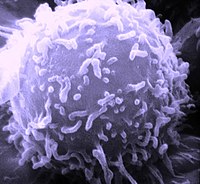
Photo from wikipedia
ABSTRACT Channel catfish (Ictalurus punctatus) leukocyte immune‐type receptors (IpLITRs) control various innate immune cell effector responses including the phagocytic process. This large immunoregulatory receptor family also consists of multiple receptor‐types… Click to show full abstract
ABSTRACT Channel catfish (Ictalurus punctatus) leukocyte immune‐type receptors (IpLITRs) control various innate immune cell effector responses including the phagocytic process. This large immunoregulatory receptor family also consists of multiple receptor‐types with variable signaling abilities that is dependent on their inherent or acquired tyrosine‐containing cytoplasmic tail (CYT) regions. For example, IpLITR 2.6b associates with the immunoreceptor tyrosine‐based activation motif (ITAM)‐containing adaptor molecule IpFcR&ggr;‐L, and when expressed in mammalian cells it activates phagocytosis using a similar profile of intracellular signaling mediators that also regulate the prototypical mammalian Fc receptor (FcR) phagocytic pathway. Alternatively, IpLITR 1.1b contains a long tyrosine‐containing CYT with multifunctional capabilities including both inhibitory and stimulatory actions. Recently, we demonstrated that IpLITR 1.1b activates a unique phagocytic pathway involving the generation of multiple plasma membrane extensions that rapidly capture extracellular targets and secure them on the cell surface in phagocytic cup‐like structures. Occasionally, these captured targets are completely engulfed albeit at a significantly lower rate than what was observed for IpLITR 2.6b. While this novel IpLITR 1.1b phagocytic activity is insensitive to classical blockers of phagocytosis, its distinct target capture and engulfment actions depend on the engagement of the actin polymerization machinery. However, it is not known how this protein translates target recognition into intracellular signaling events during this atypical mode of phagocytosis. Using imaging flow cytometry and GST pulldown assays, the aims of this study were to specifically examine what regions of the IpLITR 1.1b CYT trigger phagocytosis and to establish what profile of intracellular signaling molecules likely participate in its actions. Our results show that in stably transfected AD293 cells, the membrane proximal and distal CYT segments of IpLITR 1.1b independently regulate its phagocytic activities. These CYT regions were also shown to differentially recruit various SH2 domain‐containing intracellular mediators, which provides new information about the dynamic immunoregulatory abilities of IpLITR 1.1b. Overall, this work further advances our understanding of how certain immunoregulatory receptor‐types link extracellular target binding events to the actin polymerization machinery during a non‐classical mode of phagocytosis. Graphical abstract Figure. No Caption available. HighlightsDistinct regions of the IpLITR 1.1b CYT can independently trigger phagocytosis.Distinct regions of the IpLITR 1.1b CYT can differentially recruit intracellular signaling molecules.Imaging flow cytometry can functionally distinguish the phagocytic activities of different IpLITR‐types.New models are provided to explain the atypical mode of IpLITR 1.1b‐mediated phagocytosis.
Journal Title: Developmental and Comparative Immunology
Year Published: 2017
Link to full text (if available)
Share on Social Media: Sign Up to like & get
recommendations!